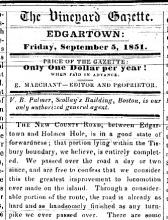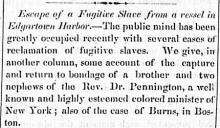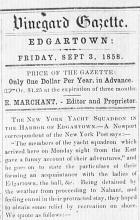The Dukes County Historical Society has solved the space problem it has been struggling with for most of its 66 years with the purchase of the John Vinson House on School street.
Saturday the society will open the property to the public as part of the Christmas in Edgartown celebration with a smattering of exhibits showing the Vineyard’s long and interesting history, as well as the history of the historical society.
The Greek-revival style house, formerly owned by George and Judith Strimel, was bought in July for $750,000, adding more than 5,000 square feet of interior space for exhibits, classes, archives and artifacts.
The purchase also launched a $2.4 million capital fund drive to buy the home, finish restoring and preserving the Thomas Cooke House and the Jirah Luce House and increase the society’s endowment fund.
Yesterday, S. Bailey Norton, former president of the historical society and co-chairman of the initial gifts drive, said cash and pledged gifts to date total $275,000.
“Recent activity in the initial gifts segment of the campaign indicated that several substantial gifts will be received between now and the year’s end,” he said. “Although the response by members and friends has been encouraging, it will be necessary to expand the campaign organization and increase solicitation efforts in 1990.”
Mr. Norton and Edward (Peter) Vincent Jr. are overseeing the initial gifts campaign, while Donald Vose serves as general chairman of the campaign.
Society genealogist Catherine Mayhew and registrar Dorothea Looney are digging into ancient deeds in the Dukes County courthouse to prove the home once belonged to John Vinson, a shoemaker during the 19th century.
Documents show that Mr. Vinson bought 19 and 3/4 rods of property from Thomas Cooke Jr. in 1833, Mrs. Halperin said. Mr. Vinson’s son, John Neal Vinson, became the customs officer during the late 19th century.
Already the rooms in the house are coming alive with exhibits - unidentified black and white photographs tinged with yellow, a white embroidered gown, a black gown with a bustle back and hats from the Civil War.
One sunny room is dotted with hand-embroidered samplers on linen. Another holds the skull of a wild boar, a powder horn engraved with battle maps and other artifacts.
The one-day exhibit will be open to the public Saturday from 10 a.m. until 4 p.m. Mrs. Halperin said the society will formulate a plan for the building by February and hopes to open the building in June.
“We need more space for almost everything we do,” Mrs. Halperin said. “It will be a total reorganization of space. We will be setting a schedule of priorities because our time schedule depends upon the success of fund raising.”
In the current museum, which also serves as a library and office building, every square inch of space is being used. The basement is filled with books, deeds, customs records, photographs, postcards, maps, films, oral history files, newspaper clippings and historical artifacts. Even the attics are filled.
“We would like to work more closely with the schools and the history teachers,” she said. A genealogy class which the society sponsored this fall was held in the Vineyard Haven library because of the lack of space at the society headquarters.
Mrs. Halperin said the John Vinson House, next door to the existing headquarters, is the perfect solution to the long-standing problem. Three years ago, the society drew up plans for a three-story, climate-controlled building on the land on the corner of School and Cooke streets. The ambitious plan was abandoned because it seemed financially impossible. Plans to preserve the Thomas Cooke and Jirah Luce house took precedent.
“This house has been so changed that we really can’t treat it historically,” she said. But many of the changes will benefit the society. The numerous expansions of the house, the insulation and central heating will protect the precious bits of Vineyard history. The two-car garage will provide workshop space or room for storage of large items.
“It is our task to preserve all Vineyard history for all Vineyard residents and provide a basic knowledge of the history for visitors,” Mrs. Halperin said. “This will help us accomplish that.”

From the April 13, 1990 edition of the Vineyard Gazette:
Historical Society Unearths the Story of Its New Property on School Street
Condominiums on the Vineyard are not new, as the Dukes County Historical Society discovered in researching the origins of its recently acquired property at 59 School street.
An Edgartown street map dating from the mid-1800s indicated that J.N. Vinson lived directly adjacent to what is now known as the Thomas Cooke House, at the corner of Cooke and School streets. The society’s new property next door, it seemed, would have been the dwelling place of J.N. Vinson’s father, John Vinson, who was appointed Collector of Customs for Edgartown by Abraham Lincoln.
The society, continuing its tradition of naming historic houses after their first owners, last fall announced that the new acquisition would be called the John Vinson House, after its presumed first inhabitant.
Not so, it turned out. Kay Mayhew, the society genealogist, together with Dorothea Looney, the society registrar, needed to delve deeper to complete the society’s conveyance records. Their search led them through endless deeds and maps, as well as a copy of the 1850 census.
There, they learned that the house at 59 School street had been first occupied by Capt. Francis Pease, his wife, and their two children. Captain Pease’s name had also been noted on the old Edgartown street map, but one house over from the little black square marked J.N. Vinson.
The unaccounted-for black square on the map was causing some confusion. The question arose: At some earlier time had there been another house located between those of Thomas Cooke and Francis Pease?
More digging unearthed the discovery that the building John Vinson had owned on School street was not a separate structure, but was in fact the second floor of the Thomas Cooke House. In 1859, Vinson had purchased the second story, half the garret, and use of half the basement. (Later, he bought the remaining portion of the property.)
It was not uncommon, society records indicate, for homes to have been divided among different owners during the 19th century. A will would often bequeath the ground floor of a structure to the eldest son, and the second floor to the widow and children. In this way, portions of the same structure came to be owned by different people. Indeed, at the time the society acquired the Thomas Cooke House in 1930, it was occupied by two different families.
Capt. Francis Pease, on the other hand, purchased from Thomas Cooke two parcels of land with no existing structures, and he had his own house built there in the 1840s.
A master mariner and whaling captain, Captain Pease was the son of Josiah and Anna (Marchant) Pease. He was born in Edgartown in 1815, and died there in 1872. His wife, the former Susan Ripley, and son, Francis Pease Jr., inherited the house. Following Mrs. Pease’s death in 1908, the property was sold and has been altered in appearance over the years.
The Capt. Francis Pease House will be the new home of the Dukes County Historical Society’s museum, library, reading room, and staff offices. It is expected to open to the public in June.











Comments